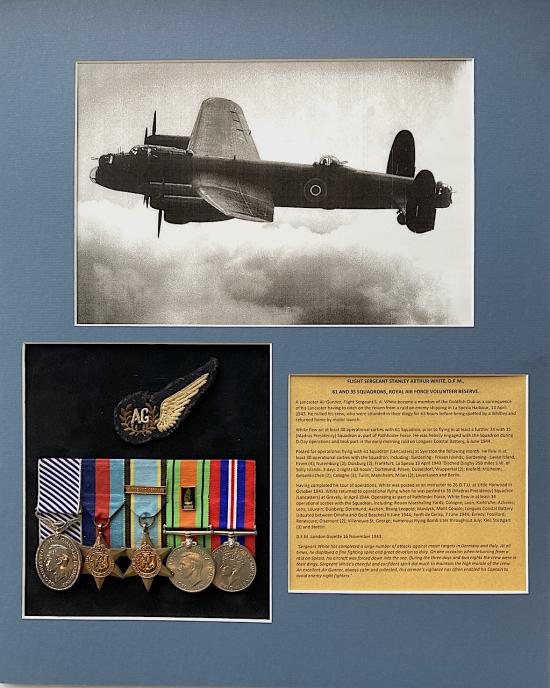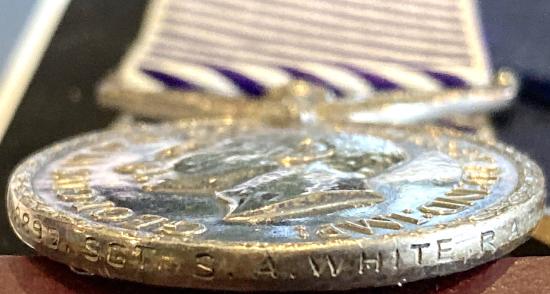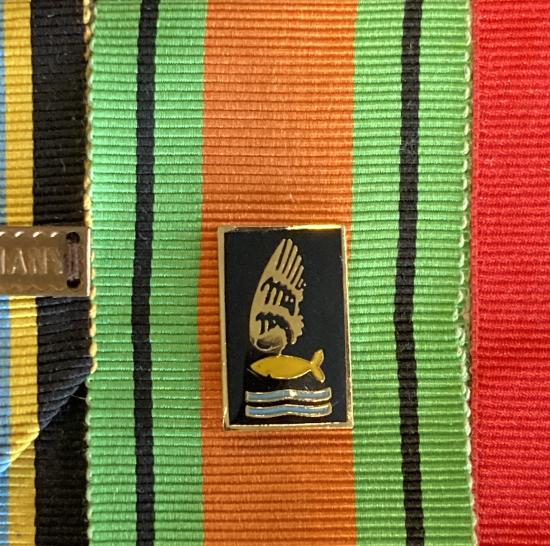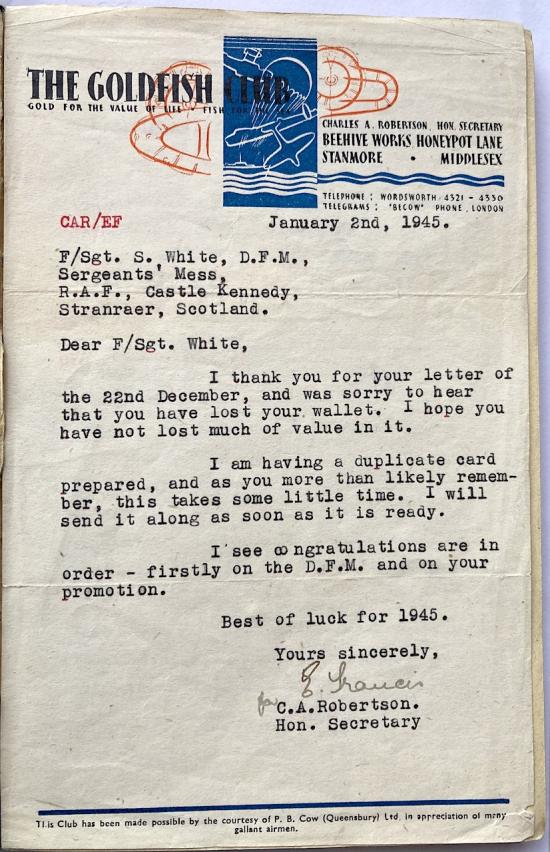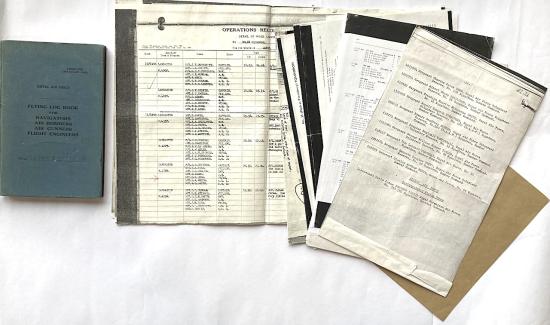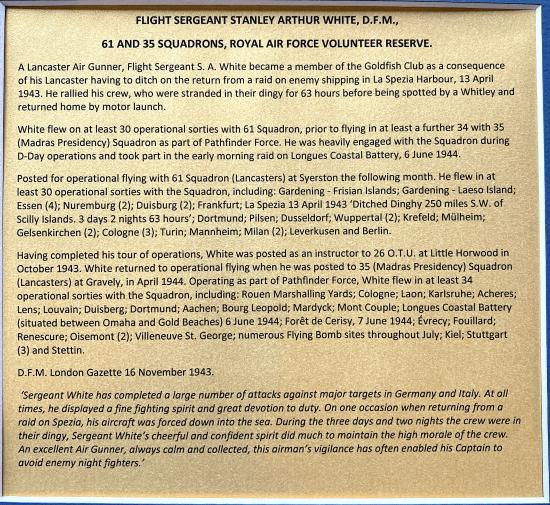WW2 RAF DFM GROUP TO LANCASTER AIR GUNNER F/S S.A WHITE
WW2 ‘1943’ D.F.M. group of five awarded to Lancaster Air Gunner Flight Sergeant S. A. White, Royal Air Force Volunteer Reserve, a member of the Goldfish Club as a consequence of his Lancaster having to ditch on the return from a raid on enemy shipping in La Spezia Harbour, 13 April 1943. He rallied his crew, who were stranded in their dingy for 63 hours before being spotted by a Whitley and returned home by motor launch.
White flew in at least 30 operational sorties with 61 Squadron, prior to flying in at least a further 34 with 35 (Madras Presidency) Squadron as part of Pathfinder Force. He was heavily engaged with the Squadron during D-Day operations, and took part in the early morning raid on Longues Coastal Battery, 6 June 1944
Distinguished Flying Medal, G.VI.R. (618899. Sgt. S. A. White. R.A.F.); 1939-45 Star; Air Crew Europe Star, clasp, France and Germany; Defence and War Medals 1939-45, mounted for display, with Goldfish Club lapel badge, good very fine.
D.F.M. London Gazette 16 November 1943. Details included in a R.A.F. Press Release state: ‘Sergeant White has completed a large number of attacks against major targets in Germany and Italy. At all times, he displayed a fine fighting spirit and great devotion to duty. On one occasion when returning from a raid on Spezia, his aircraft was forced down into the sea. During the three days and two nights the crew were in their dingy, Sergeant White’s cheerful and confident spirit did much to maintain the high morale of the crew. An excellent Air Gunner, always calm and collected, this airman’s vigilance has often enabled his Captain to avoid enemy night fighters.’
Stanley Arthur White served during the Second War with the Royal Air Force Volunteer Reserve. He carried out his initial training as an Air Gunner at No. 2 A.G.S., Dalcross, from November 1942. White was posted to No. 1660 Conversion Unit at Swinderby in January 1943, before being posted for operational flying with 61 Squadron (Lancasters) at Syerston the following month. He flew in at least 30 operational sorties with the Squadron, including: Gardening - Frisian Islands; Gardening - Laeso Island; Essen (4); Nuremburg (2); Duisburg (2); Frankfurt; La Spezia 13 April 1943 ‘Ditched Dinghy 250 miles S.W. of Scilly Islands. 3 days 2 nights 63 hours’ (Logbook refers); Dortmund; Pilsen; Dusseldorf; Wuppertal (2); Krefeld; Mülheim; Gelsenkirchen (2); Cologne (3); Turin; Mannheim; Milan (2); Leverkusen and Berlin. The raid on La Spezia, 13/14 April 1943, consisted of ‘208 Lancasters and 3 Halifaxes which bombed the dock area... and caused heavy damage. 4 Lancasters were lost and 3 more, either damaged or in mechanical difficulty, flew on to land at Allied airfields in North Africa. It is believed that this was the first occasion that the recently captured North African airfields were used for Bomber Command aircraft in distress. The 3 Lancasters flew back to England later.’ (Bomber Command War Diaries refer) White’s Lancaster, piloted by Flying Officer M. E. Chivers, was one of the 4 Lancasters to be lost on the raid.
The Squadron’s Operations Record Book gives the following: ‘Attack on Battleships in Harbour At Spezia. F/O Chivers bombed from 8,000 ft. Battleship was seen and bombed but no results were observed. No. P.F.F. flares at Lake Bourget were seen on the way home. Little of no navigational aid was received, the aircraft eventually ditched S.W. of Scillies. Crew sighted by Whitley A/C after 63 hours in the sea and picked up by launch.’
Having completed his tour of operations, White was posted as an instructor to 26 O.T.U. at Little Horwood in October 1943. White returned to operational flying when he was posted to 35 (Madras Presidency) Squadron (Lancasters) at Gravely, in April 1944.
Operating as part of Pathfinder Force, White flew in at least 34 operational sorties with the Squadron, including: Rouen Marshalling Yards; Cologne; Laon; Karlsruhe; Acheres; Lens; Louvain; Duisberg; Dortmund; Aachen; Bourg Leopold; Mardyck; Mont Couple; Longues Coastal Battery (situated between Omaha and Gold Beaches) 6 June 1944; Forêt de Cerisy, 7 June 1944; Évrecy; Fouillard; Renescure; Oisemont (2); Villeneuve St. George; numerous Flying Bomb sites throughout July; Kiel; Stuttgart (3) and Stettin.
White advanced to Flight Sergeant and was posted as an instructor to the Gunnery School at R.A.F. Castle Kennedy, Stranraer. Includes the following documentation: Royal Air Force Flying Logbook for Navigators Air Bombers Air Gunners Flight Engineers (21 November 1942 - 18 August 1944) some of records filled in in pencil, all not signed off or stamped, possibly a replacement; letter to recipient from The Goldfish Club regarding a replacement membership card due to loss of wallet, dated 2 January 1945. Numerous other papers and records regarding his D.F.M., the ditching, operations records and other stuff.
Code: 50243

